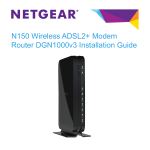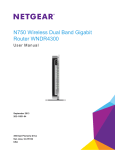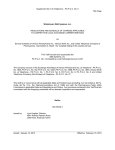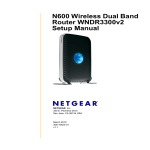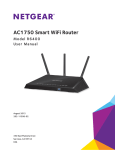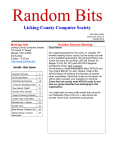Download for North America
Transcript
Technical Support Package Contents Thank you for selecting NETGEAR products. The box should contain the following items. If any items are incorrect, missing, or damaged, contact your NETGEAR dealer. N600 Wireless Dual Band Gigabit ADSL2+ Modem Router DGND3700v2 Installation Guide ADSL Phone Go to support.netgear.com for product updates and web support. Line After installing your device, locate the serial number on the label of your product and use it to register your product at NETGEAR.com/register. Registration is required before you can use our telephone support service. Registration through our website is strongly recommended. ADSL filter Th ADSL filter provided The depends on the region. de N600 Wireless Modem Router NETGEAR, Inc. 350 East Plumeria Drive San Jose, CA 95134, USA March 2012 Phone cable Ethernet cable Power adapter Compliance You can use this diagram to connect your modem router to ADSL (1a) or Cable/Fiber (1b), or you can follow the instructions in this booklet. 1a: For ADSL Internet Declarations of Conformity For complete DoC please visit the NETGEAR EU Declarations of Conformity website at: support.netgear.com/app/answers/detail/a_id/11621/. For GNU General Public License (GPL) related information, please visit support.netgear.com/app/answers/detail/a_id/2649. This symbol is placed in accordance with the European Union Directive 2002/96 on the Waste Electrical and Electronic Equipment (the WEEE Directive). If disposed of within the European Union, this product should be treated and recycled in accordance with the laws of your jurisdiction implementing the WEEE Directive. 2. Computer Internet OR 3 Power 3. 1b: For Cable/Fiber Internet 4. Browser Internet Cable/Fiber Modem Open browser and follow instructions for installation Contents Before You Begin . . . . . . . . . . . . . . . . . . . . . . . . . . . . . . . . . . . 2 Install Your Modem Router . . . . . . . . . . . . . . . . . . . . . . . . . . . . . 4 Preset Wireless Security . . . . . . . . . . . . . . . . . . . . . . . . . . . . . . 8 Wireless Network Settings . . . . . . . . . . . . . . . . . . . . . . . . . . 9 Add Wireless Devices to the Network . . . . . . . . . . . . . . . . . . . 10 WPS Method. . . . . . . . . . . . . . . . . . . . . . . . . . . . . . . . . . . 10 Manual Method . . . . . . . . . . . . . . . . . . . . . . . . . . . . . . . . . 10 Access the N600 Router to Make Changes . . . . . . . . . . . . . . 11 Troubleshooting . . . . . . . . . . . . . . . . . . . . . . . . . . . . . . . . . . . . 13 ReadySHARE Access . . . . . . . . . . . . . . . . . . . . . . . . . . . . . . . 15 USB Control Center . . . . . . . . . . . . . . . . . . . . . . . . . . . . . . . . . 17 Control Center Configuration . . . . . . . . . . . . . . . . . . . . . . 18 USB Printer. . . . . . . . . . . . . . . . . . . . . . . . . . . . . . . . . . . . 19 Scan with a Multifunction Printer . . . . . . . . . . . . . . . . . . . 20 USB Speaker . . . . . . . . . . . . . . . . . . . . . . . . . . . . . . . . . . 20 Other Features . . . . . . . . . . . . . . . . . . . . . . . . . . . . . . . . . . . . . 21 Before You Begin You can connect directly to a DSL line or to a fiber/cable modem. Note: If you are connecting to a DSL line, make sure that your DSL service is active before you install the modem router. You need the information listed here to install your DSL modem and connect to the Internet. Please locate it and have it on hand before you start the installation procedure. • DSL user name and password. These are usually included in the welcome letter your DSL ISP sent you when you signed up for your service. Record your DSL Internet service account user name and password here: User name: Password: • Your telephone number or DSL account number. If you do not have voice service, you can use your DSL account number in place of a phone number. If you don’t know or cannot locate your user name and password, call your DSL Internet service provider. The table on the next page lists the contact information for some of the primary DSL providers. Be very specific when speaking with your DSL Internet service provider. For example, you could say: I need my DSL service user name and password. Can you help me? Note: If your provider says they do not support NETGEAR devices, tell them you need only your DSL user name and password; you do not need support. 2 DSL Internet Service Provider Phone Number AT&T DSL (not AT&T U-Verse) 877-722-3755 AT&T/BellSouth DSL (not AT&T U-Verse) 888-321-2375 CenturyLink 800-809-1410 Covad DSL 888-642-6823 EarthLink 888-829-8466 Qwest 800-247-7285 SureWest 888-639-1611 TDS DSL Support 866-571-6662 US Family 800-300-4256 Verizon 800-567-6789 Windstream 877-901-4692 3 Install Your Modem Router Note: Keep your modem router in a vertical position. To install your modem router: 1. Connect to the Internet with ADSL or Ethernet WAN. You can connect either directly to a DSL line or to a fiber/cable modem. a. Connect to ADSL (if connecting directly to a DSL line). Internet 1 • Install an ADSL microfilter between the phone line and the phone. A microfilter filters DSL interference out of standard phone equipment that shares the same line with DSL service. Example devices are telephones, fax machines, answering machines, and caller ID displays. • Connect the ADSL port of the modem router to the ADSL port of the microfilter. 4 Note: Use an ADSL microfilter for every phone line in the house if your modem router and telephone connect to the same phone line. Plugs into ADSL line b. Connect to Cable/Fiber (if connecting to a cable/fiber modem). 1 Internet Cable/Fiber Modem 2. Cable your computer. Use an Ethernet cable (not provided). Internet 2 Internet 5 3. Power on your router. Internet 3 Internet 2.4 GHz Wi l Wireless LED a. Connect the power adapter to the router, and plug the power adapter into an outlet. b. Wait until the 2.4 GHz Wireless LED green. 4. Open a browser. If a web page does not open, close and reopen the browser, and enter http://routerlogin.net in the address bar. See Troubleshooting on page 13. turns solid 4 Enter the router user name admin and default password password. Click OK. When the main settings screen opens, you are asked if you want to check for an update. Click Cancel. You can always check for new firmware later after you are connected to the Internet. 6 5. Connect to the Internet. Select Advanced > Setup Wizard to display the Setup Wizard screen. Make sure Yes is selected. Then click Next and follow the prompts to complete the Setup Wizard and be connected to the Internet. Note for DSL users: If your DSL ISP requires that you enter a user name or password, you are prompted to enter this information. If you do not have this information, contact your DSL ISP (for more information, see Before You Begin on page 2). 6. After connecting to the Internet, check for firmware updates by selecting Advanced > Administration > Router Upgrade and following the on screen prompts. 7. Click Logout and close your browser. You are now able to enjoy your Internet service with the NETGEAR DGND3700v2 N600 Wireless Modem Router. 7 Preset Wireless Security This product has a unique WiFi network name (SSID) and network key (password). The default SSID and network key (password) are uniquely generated for every device, like a serial number, to protect and maximize your wireless security. This information is located on the label on the bottom of the product. WiFi Network Name (SSID) Network Key (Password) NETGEAR recommends that you do not change the preset WiFi network name (SSID) and network key (password). If you do change the settings, the security SSID and password on the bottom of the product no longer apply. Note: Your network names (SSIDs) and passphrases are casesensitive. Your network name, security method, and passphrase need to be the same for all the wireless devices connected to your router on a network. 8 Wireless Network Settings Record the default preset wireless settings that are printed on the label in the spaces here for easy reference. 2.4 GHz WiFi network name (SSID): 2.4 GHz network key (password): 5 GHz WiFi network name (SSID): 5 GHz network key (password): If you change the default settings, record them here for easy reference, and then store this booklet in a safe place: 2.4 GHz WiFi network name (SSID): 2.4 GHz network key (password): 5 GHz WiFi network name (SSID): 5 GHz network key (Password): To retrieve or update your wireless password, type http://www.routerlogin.net in a web browser and log in using the default user name (admin) and password (password). Select Basic > Wireless Settings to locate your wireless passwords. 9 Add Wireless Devices to the Network Choose either the manual or Wi-Fi Protected Setup (WPS) method to add wireless computers and other devices to your wireless network. WPS Method If your wireless device supports WPS (Wi-Fi Protected Setup)— NETGEAR calls this method Push 'N' Connect—you might be prompted to press the WPS button on the router instead of entering a password. If this happens: 1. Press the WPS button on the router. 2. Within 2 minutes, press the WPS button on the client device, or follow the WPS instructions that came with your wireless device to complete the WPS process. The device will then be connected to your router. 3. Repeat this process to add other WPS wireless devices. Note: WPS does not support WEP security. If you try to connect a WEP client to your network using WPS, it will not work. Manual Method 1. On the wireless device that you want to connect to your router (iPhone, laptop, computer, gaming device), open the software utility that manages its wireless connections. This utility scans for all wireless networks in your area. 2. Look for the preset NETGEAR WiFi network name (SSID) and select it. The SSID is located on the product label on the bottom of the router. Note: If you changed the name of your network during the setup process, look for that network name. 3. Enter the preset password (or your custom password if you changed it), and click Connect. 10 Repeat steps 1–3 to add other wireless devices. Access the N600 Router to Make Changes After you use NETGEAR Genie to set up the router, you can log in to the router to view its settings or make changes. To log in to the router: 1. Launch a web browser from a computer or wireless device that is connected to the router. 2. Type www.routerlogin.net or www.routerlogin.com in the address field of the browser. A login screen displays: 3. Enter admin for the user name and password for the password. The NETGEAR genie screen displays: 11 See the User Manual for more information about the router screens. To change the password for the router user name: 1. Log in to the router. 2. Select Advanced > Administration > Set Password to display the Set Password screen: 3. Type your old password, and type the new password twice. 12 Troubleshooting If the browser does not display the web page: • Make sure that the computer is connected to one of the four LAN Ethernet ports, or wirelessly to the router. • Make sure that the router is fully up and running. Its WiFi LED should turn on. • Close and reopen the browser to make sure that the browser does not cache the previous page. • Browse to http://routerlogin.net. • If the computer is set to a static or fixed IP address (this is uncommon), change it to obtain an IP address automatically from the router. If the modem router does not power on: 1. Check your cables. • Disconnect and reconnect each cable. There is usually an audible click when the cable is correctly connected. • See if the telephone cable connecting your DSL modem router to the wall jack is plugged into a filter. A filter is not required if you do not have telephone voice service. A filter installed where it is not needed might eliminate your ADSL signal. 2. Power down your DSL modem router, and then power it up again. a. Shut down your computer and turn off the modem router. b. Unplug the power adapter and all other cables from the back of the DSL modem router. c. Wait 30 seconds, then reconnect the cables and adapter to your DSL modem router, and turn it on. d. Make sure that the router power light is on. If the light is off, try plugging the adapter into another power outlet. 13 e. Turn your computer back on, and wait for the indicator lights to turn green. 3. Open a web browser and try to access the Internet. If steps 1–3 do not resolve the problem: 4. Reset your modem. To reset your DSL modem router, use a pin or paper clip to press in and hold the Reset button. 14 ReadySHARE Access After installation and set-up, you can insert a USB storage device into the USB port on the modem router and share the contents with other network users. (If your USB device has special drivers, it is not compatible.) Note: If your USB device requires a power supply, you have to use it when connecting your USB device to a NETGEAR router or gateway. It might take up to 2 minutes before the USB drive is ready for sharing after it is connected to the router. To access your USB device: On Windows systems, use any of these methods: • Select Start > Run and enter \\readyshare in the dialog box. Click OK. • Open Explorer or Safari and enter \\readyshare in the address bar. • Open My Network Places, and enter \\readyshare in the address bar. On Mac systems, do this: 1. Select Go > Connect to Server. 2. Enter smb://readyshare as the server address. 3. Click Connect. 15 The readyshareconnect.exe file (for Windows) is available to download here: www.netgear.com/readyshare 16 USB Control Center The USB Control Center utility allows you to control a shared USB device from your computer that is connected to the USB port on your router. The utility allows you to control a printer. The utility has to be installed on each computer on your network from which you want to control the device. You can download this utility at www.netgear.com/landing/en-us/readyshare.aspx. When you launch the USB Control Center utility, a screen similar to the following displays: This is the main screen, which shows a device icon, the description for this USB device, and its status. Available. The device is available from the computer that you are using. Waiting to Connect. You need to connect to this device from the computer that you are using. If this is the first time you are connecting, you might be prompted to install the device driver. 17 The following menu selections are available: • System. Exit the utility. • Tools. Access the Control Center Configuration to set up your shared USB device. See the following section, Control Center Configuration. • About. View details about the USB Control Center software. Control Center Configuration Select Tools > Configuration to display the following screen: Automatically execute when logging on Windows. Select this checkbox to have the utility start automatically when you are logged in to Windows. Timeout. Specify the time-out value for holding the USB resource when it is not in use. 18 Language. Select the display language for this utility. USB Printer The first time you use a printer, you need to click Connect. You might be asked to install the driver for this printer. After the driver is installed, the printer status changes to Available. Note: Some USB printers (for example: HP and Lexmark printer) request that you do not connect the USB cable until you are prompted by the installation software. If the USB printer is detected and connected automatically, you need to disconnect the printer, and then wait for the prompt asking you to click Connect. Once the printer shows Available status, the grayed out Paused state no longer displays in the Windows Printers and Faxes window. This USB printer is ready. The utility does not need to always hold the connection of this USB printer. Once there is any print job for this printer, the USB utility connects to this USB printer automatically, then 19 prints. After the print job is done, the printer status returns to the Paused state. Scan with a Multifunction Printer You can use the scan feature of a multifunction printer. 1. Make sure that the printer’s status shows as Available. 2. Click the Network Scanner button. This activates the scanner window that is used to perform the scans. USB Speaker To control a USB speaker: 1. Select the USB speaker. 2. Click the Connect button to connect this speaker, or click Disconnect to disconnect the speaker. If you click Connect, and someone else is already connected to the speaker, a request is sent to that person. The person who receives the request can click an Accept or Reject button. If someone is connected to the speaker and it is not being used (the router does not detect any activity), the router holds the connection for the amount of time that is in the timeout value, and then makes it available. 20 Other Features For additional features, including Live Parental Controls, Traffic Metering, ReadySHARE, Guest Access, and more, please log into your router at http://routerlogin.net. © 2012 NETGEAR, Inc. All rights reserved. No part of this publication may be reproduced, transmitted, transcribed, stored in a retrieval system, or translated into any language in any form or by any means without the written permission of NETGEAR, Inc. DO NOT stack equipment, or place equipment in tight spaces or in drawers. Be sure your equipment is surrounded by at least 2 inches of air space. Trademarks NETGEAR, the NETGEAR logo, and Connect with Innovation are trademarks and/or registered trademarks of NETGEAR, Inc. and/or its subsidiaries in the United States and/or other countries. Information is subject to change without notice. Other brand and product names are registered trademarks or trademarks of their respective holders. © 2011 NETGEAR, Inc. All rights reserved. Statement of Conditions In the interest of improving internal design, operational function, and/or reliability, NETGEAR reserves the right to make changes to the products described in this document without notice. NETGEAR does not assume any liability that may occur due to the use or application of the product(s) or circuit layout(s) described herein. 21


































